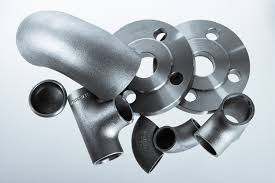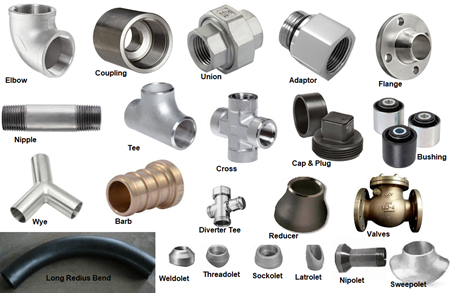 2. The standard specifications for the calculation method of pipe fittings
2. The standard specifications for the calculation method of pipe fittings2.1 The calculation method of pipe fittings based on standards
Domestic and foreign standards have provisions on the calculation method of pipe fittings. MSS SP-75-2008 Superior Steel Butt Welded Pipe Fittings and ASME B16.9-2007 Forged Steel Butt Welded Pipe Fittings Manufactured by Factories stipulate the calculation of pipe fittings by adopting mathematical analysis or verification testing methods. The domestic pipe fitting standard SY/T 0609-2006 Specifications for Superior Steel Butt Welding Pipe Fittings also stipulates this. In addition to the mathematical analysis and verification testing methods, SY/T 0510-2010 Specifications for Steel Butt Welded Pipe Fittings also specifically stipulates that the equal area reinforcement method can be used for the drawn tee and the elbow is calculated by the ring pipe formula. It is stipulated that the tee shall be calculated by the equal area reinforcement method in GB 50251-2015 Design Specifications of Gas Pipeline Engineering.
2.2 Differences in standards
Although similar technical regulations are made for calculation methods of the pipe fitting in many standards, there are still differences in the requirements of the pipe fitting standards in the verification test after careful analyses. When the verification test method is used for the verification of pipe fittings, different problems will occur. Therefore, the better standard is the first issue to be determined.
2.3 Recommended pipe fitting standards
It is recommended that foreign standards such as MSS SP-75-2008 Specifications for High-quality Steel Butt Welded Pipe Fittings should be used for the verification test of pipe fittings, especially the drawn tee. If the pipeline transporting oil and gas has a more demanding high-pressure and low-temperature environment, ASTM A860 or A860 M-00 Technical Specifications for High-impact Low Alloy Forged Steel Butt Welded Pipe Fittings should be adopted; temperature of the impact toughness test of pipe fittings specified in the standard is -46℃, and the maximum hardness of the required pipe fittings should be 22 HRC. Some literature points out that the influence of size effect must be considered for the low-temperature fracture toughness of X80 large-diameter tees.
3 Related issues of using the verification test method
3.1 The verification test is the basis of the verification test method.
The method of verification test formula of the test pressure and coverage of the qualified verification test pipe fittings are specified in the pipe fitting standard.
3.2 Applicable scopes of qualified verification tests
The structural type and size of the sample pipe fittings used for the verification test must meet the standard requirements. Under this premise, the verification test method can be used to determine the wall thickness of similar pipe fittings.
 3.3 The required manufacturing process specifications for the verification test of pipe fittings
3.3 The required manufacturing process specifications for the verification test of pipe fittingsThe performance of the pipe fittings, especially the mechanical properties, metallographic structure and impact toughness that ensure their strength and safety, are greatly affected by the pipe fitting manufacturing process. In particular, the performance of the raw materials, the thermal processing technology and the heat treatment process determine the performance of pipe fittings. There are also corresponding regulations in MSS SP-75-2008 Specifications for Hight-quality Steel Butt Welded Pipe Fittings. Therefore, different pipe fitting companies should have their own verification tests to determine the wall thickness of the pipe fittings, instead of getting other companies' tests for results.
3.4 The verification test of pipe fittings may be repeated.
Using the verification test method to determine the wall thickness of the pipe fittings is advanced compared to the mathematical analysis method, but the data obtained by using the qualified pipe fittings of the verification test is not necessarily optimized and the wall thickness determined by this method is not necessarily optimized. With different pipe fitting companies to use the same verification test method, the determined wall thickness of pipe fittings is different. Therefore, the verification test of pipe fittings may have to be carried out many times, from which the optimized data and manufacturing process can be sifted and used as the optimization data and manufacturing process specifications for determining the wall thickness of pipe fittings in the future.
4. Conclusion
(1) The verification test method of pipe fitting design calculation is better than the mathematical analysis method, so the verification test method should be used to determine the wall thickness of pipe fittings. This is not only suitable for high pressure and large diameter pipe fittings, but also for medium and low pressure as well as medium and small diameter pipe fittings.
(2) Because the wall thickness of the pipe fittings determined by the verification test method is greatly reduced, the technical problems in the material, manufacturing process and equipment of the high-pressure large-diameter pipe fittings made by the pipe fitting company are naturally eliminated, and performance as well as quality of pipe fittings are guaranteed. The safety of pipe fittings and pipeline engineering is also guaranteed.
(3) The basis of using the verification test method to determine the wall thickness of the pipe is the verification test. The verification test of pipe fittings may be performed many times, including the optimization of the pipe manufacturing process.
(4) The structural type, size and manufacturing process of pipe fittings after the optimized and qualified verification test should become standard specifications for pipe fittings within the applicable scope in the future.